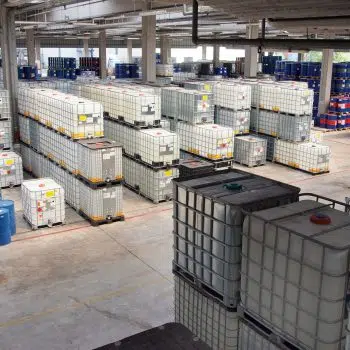In November 2018 WorkSafe updated its guidance materials on storing chemicals in the workplace. The guide outlines some of the common health and safety risks for storing chemicals and provides guidance on how to manage those risks. It includes a storage checklist that sets out the standard precautions everyone should take and a detailed chart that shows which types of chemicals to separate and by how far.
The following article provides you with some of the key points to consider when storing chemicals.
Why is it Important to Safely Store Hazardous Chemicals?
Even when not in use, chemicals can still pose a risk. Flammable and oxidizing chemicals may cause or contribute to a fire, corrosive chemicals can injure people and damage property and structures they come into contact with and toxic chemicals can poison people who are exposed to them. Compressed gases can also suffocate or poison workers if they leak.
Some chemicals are not compatible with one another and when incompatible chemicals mix they may:
- ignite or explode
- release toxic, flammable or corrosive gases, or
- corrode chemical containers, causing them to leak.
It’s important that you identify which chemicals are incompatible and ensure that hazardous chemicals are stored safely in a way that:
- minimises the chance of any incidents and reactions, and
- reduces the chance that stored chemicals will contribute to or worsen an incident.
When identifying chemical incompatibility you should also consider:
- combustible materials such as wood or paper, which may increase the likelihood or severity of a fire
- non-hazardous chemicals that may react with hazardous chemicals
- the materials that containers are made out of, as some hazardous chemicals are not compatible with the materials other chemicals containers are stored in, for example, aluminium containers may react with strong alkaline solutions
- potential ignition sources, including work areas that may be used for hot work such as welding or grinding, and
- firefighting equipment, as the equipment suitable for one hazardous chemical, may not be suitable for all chemicals you store.
The following diagram provides the hierarchy of control measures when managing the storage of chemicals.

Separating Incompatible Chemicals
Separating incompatible chemicals is one of the most important controls when storing hazardous chemicals.
Separation techniques include using:
- distance
- barriers
- separate rooms
- separate buildings, and
- external storage tanks.
Distance should only be used when the risk of a reaction is low. Generally, a minimum distance of 3 metres is recommended between any incompatible goods, though this may be increased or decreased depending on the level of risk. Bunding and spill trays should be in place, and distances should be measured horizontally from the edge of any spill containment system. Incompatible chemicals should never share the same bunding or drainage systems, and liquids should not be stored above solids.
Barriers include chemical storage cabinets, partitions between chemicals, and partitions around storage areas. Barriers should be resistant to any chemicals they are intended to contain. If using chemical storage cabinets you should make sure they meet the relevant Australian Standard for the type of chemical they store.
Separate rooms should be used when large quantities of hazardous or incompatible chemicals are stored. For example, separate fire-resistant rooms should be considered for large stores of flammable or oxidising chemicals.
Separate buildings may be necessary for chemicals that cannot be safely contained within a normal work site. These are typically large quantities of extremely hazardous or reactive chemicals. Separate buildings should also be considered for chemicals that can react with water or air, or require specialised fire-fighting systems.
External storage tanks are used for storing large quantities of hazardous chemicals. One of the most common examples is petrol storage tanks for refilling vehicles at a work site. Tanks should be located outside and away from normal work areas; this allows the chemical to be separated from workers and other materials to protect them if there is an incident. Where possible, storage tanks should be protected from impact and damage, for example with bollards, barriers or fencing
Consider the segregation chart when storing chemicals: https://www.chdpartners.com.au/wp-content/uploads/2019/09/Segregation-Chart-Managing-Risks-of-Storing-Chemicals-in-the-workplace-.pdf
Reviewing Controls Measures
For control measures to be effective they must be reviewed and maintained. It is critical to regularly review that control measures are currently based on safety data sheets and new information that is made available in guidance material and standards is critical. This includes checking the control measures are fit for purpose, suitable for the nature and duration of the work and are installed and used correctly.
Maintenance of control measures may include:
- training staff regularly to ensure they know how to store and handle chemicals safely
- checking bunds, tanks, pipework and compressed gas fittings for signs of damage
- preventative maintenance and testing programs for engineering controls such as ventilation systems, fire alarms and sprinkler systems.
Consider the following checklist when storing chemicals: https://www.chdpartners.com.au/wp-content/uploads/2019/09/Managing-Risk-of-Storing-Chemicals-in-the-Workplace-Checklist.pdf
Resources: https://www.safeworkaustralia.gov.au/doc/managing-risks-storing-chemicals-workplace
